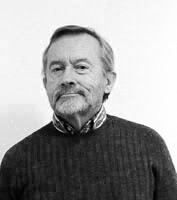Working in a variety of media throughout his career, including painting, printmaking, watercolor and sculpture, artist Igor Medvedev’s art is characterized by a focus on structure, deep colors, a masterful use of light and shadow, and a tranquil, peaceful mood.
Personal History
The serenity of Medvedev’s works contrasts sharply with the tumultuous early years of his life. Born in Kharkov, Ukraine of the former Soviet Union in 1931, the young artist’s life was shaped by the events of World War II. Medvedev’s introduction to art came with the friendship of Anatoly Martinov, a skilled local artist who was his family’s neighbor that lived with them during the war.
Following two years of the German occupation of Russia, the Medvedevs left their home country in 1943, staying in Poland and Austria before settling in Germany. The family walked for a month to avoid Russian armed forces and just before the end of the war, they reached Germany’s American-occupied zone.
During these difficult times, Medvedev found solace in his art. “There is something leading all of us toward something,” he has said. “Through life, I was motivated to create art.” Medvedev sketched the German towns he saw, finding comfort in the architectural composition. “It was a structural pursuit,” Medvedev said, “not flowers or figures, but buildings and cityscapes. It was the beginning of a feeling. As you grow and you have that feeling, you begin to use it, add to it.” This search for structure and the desire to capture it in his art would become a theme in Medvedev’s art.
For the next few years, the Medvedevs resided in Munich, Germany. It was here that the young artist began learning the art forms of bronze casting and sculpture. Igor’s artistic talent helped the family move to America. William Sudduth, the head of youth resettlement for the United Nations Relief and Rehabilitation Administration, noticed Medvedev’s abilities and expedited the family’s immigration process. He also helped Medvedev earn a scholarship to Dartmouth College in New Hampshire, which he began attending in 1948.
At Dartmouth, Medvedev was further inspired by the work of artist-in-residence Paul Sample, who was creating paintings of winter landscapes of northern New England with a focus on architecture. Three years later, after graduating from the college with a degree in art history, Medvedev continued his studies at the University of Berkeley, graduating with a Master’s degree in 1953.
Medvedev’s art was immediately well-received. Between 1954 and 1963 he had fifteen one-man exhibitions of his work in Germany and numerous exhibitions in the United States. Still, he worked as a graphic designer and draftsman in Los Angeles to support himself and his family. Though his art was affected by the popular movements of Abstract Expressionism, Pop Art and Op Art, Medvedev found himself more inclined toward figurative work and structure, particularly in the roundness of these forms.
The year 1977 proved pivotal for Medvedev – it was during this year that he married Marina, and at her insistence, the couple moved to San Francisco. After teaching for a few years at San Mateo State College and Los Altos’ Foothill College, Medvedev began exhibiting in fine galleries in San Francisco and his career took another significant turn.
During the 1990s and through 2006, Medvedev worked in the printmaking medium of serigraphy. Medvedev worked hand-in-hand with the artisans at the Romi studio in Rishon Le Zion, Israel, where the serigraphs were created to ensure that each work faithfully retained the integrity of his art. A catalogue raisonée of his serigraphs was published by Park West Gallery® in 2002, “The Serigraphs of Igor Medvedev”. The book featured an introduction by Dr. Anthony Janson, co-author of the acclaimed Janson’s History of Art (which has sold more copies than any other art book in the world). In 2007 an extended edition of the book was published by Park West Gallery®, “The Serigraphs of Igor Medvedev, Volumes I and II”.
In 2011, Medvedev created his first two lithographs ever at the Atelier Arts Litho in Paris. Medvedev had always been fascinated by lithography but only after the lithographic process became available at Arts Litho (which printed almost all of the lithographs of Marcel Mouly) was he willing to start. Stéphane Guilbaud, the director of the Atelier recently received the order of the “Maître d’Art” (a Master of Art) from the French government on the 24th of November 2010. On that date he received this rare and prestigious honor directly from Frédéric Mitterrand the Minister of Culture of France in the “Salons du Ministère” at 3, rue de Valois, Paris. The same team of printers and artisans that worked with Marcel Mouly worked directly with Medvedev in creating his first two lithographs.
Style and Influences
Seeking new inspiration for his work, Medvedev and Marina traveled extensively during the 1980s. They traveled throughout the Mediterranean but it was Greece in particular that spoke to Medvedev. He was fascinated by the Cycladic architecture – its vaults and domes. He was intrigued by both its functionality and aesthetic appeal – the architecture was favored in Greece for its ability to withstand earthquakes, but the round shapes also reminded Medvedev of the human form, particularly the roundness of the female body as expressed in sculpture.
This focus on structure provides continuity throughout Medvedev’s works, whether they feature boats, architecture, landscapes, or doors and windows as their subject. Medvedev finds a natural, organic beauty in boats, and describes their structure as essentially an inverted Cycladic dome.“There is a mystique, a symbology in boats,” Medvedev said. “They carry a long history in human development.” Medvedev’s boats seem to take on their own personalities, as their names often suggest: “Meditative” (2001), “Moody” (2002) and “Beloved” (2001).
In his architectural works, Medvedev is typically drawn to the villages of Greece and Turkey, moved to capture their beauty in his work as they continue to deteriorate from development and tourism. He said he has often heard the sound of bulldozing even as he is painting. The scenes are peaceful, unpopulated, and present the unique Cycladic architecture of the region in the glow of Mediterranean light. His images of doors and windows are similarly devoid of people, but – as in his works featuring boats – they take on human characteristics as well, whether “Innocent” (2001), “Demure” (2000), or “Unassuming” (2001).
“Great art has a connection to our subliminal and conscious nature, and we are inherently attracted to that subject or painting,” Medvedev said. “It’s not just a pretty picture. There’s a connection to mystery I find in all good art and it runs through all the masterpieces – an archetypal connection to our conscious. The subjects I seek have to have some element of that archetypal meaning.”
Igor Medvedev’s works are eagerly collected throughout the world. “Art is my purpose of life; it’s connected to my existence,” Medvedev once said. “It is my discipline. I try to keep it going because it keeps me going.”




